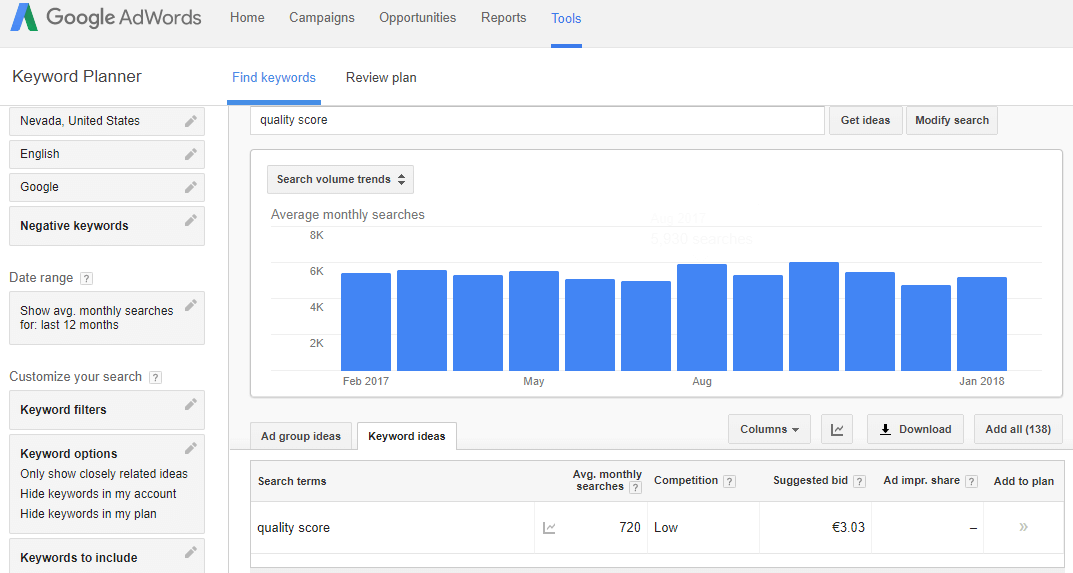
Imagine you’re talking with one of your closest friends and they tell you about this interesting bird fact that they read. “Did you know there’s only one bird in the world that has nostrils at the end of its beak? It’s the… Ah… One second,” your friend says, hesitating.
“Hold on. Let me Google it.”
Google, the search engine giant, is both a noun and a verb. The act of searching online is often referred to as “googling” something (Google’s official feelings about using “Googling” to refer to searching on any other search engine aside.) That the public has strongly embraced the use of “Google” as a verb in our vernacular is unsurprising, considering the market share Google as compared to competitors. In 2017, Google averaged a net search share of 74.54%—while Yahoo, Bing, and others averaged a 5% to 10% market share.
With a high market share and around 3.5 billion searches per day, gaining visibility on Google is a goal for many company’s advertising efforts.
The Importance of Google AdWords
Even with so many searches, the competition for top spots on Google Search Engine Results Pages (SERPs) is intense. Is there a way to get noticed without relying on the whims of Google’s search algorithm? You probably already know the answer to this. Google AdWords is Google’s paid advertising service, their main money maker, and the best way to get visibility at the top of a search engine page.
According to Google, Google AdWords can help your business attract more customers and reach them at the moment they’re searching for products or services like yours. Plus, with the option to advertise locally or globally, you can target the right geographical location each time. Whether you’re a small local business that just opened its doors or a retail chain with nationwide locations, you can benefit from using Google AdWords. Here’s how it’s done.
How to Set Up Google AdWords
If you don’t want to use a PPC management agency to set up your Google Adwords campaign, follow this step-by-step guide and you’ll have a good start. First, go to adwords.google.com and click Sign In in the upper right. If you don’t have a Google account, or want to set one up for your business, you can do it through the page that pops up.
When you first visit Google AdWords, it will give a quick tutorial and show where essential tabs are located. Google provides a great breakdown of setting up your AdWords account, but for the to-the-point version, read on.
Create Campaigns and Ad Groups
AdWords ads are broken up into campaigns and groups. If you sold bowling equipment, your products might be bowling balls, shoes, and accessories, and your campaigns and ad groups could look like:
- Campaign 1: Bowling balls
- Plastic bowling balls
- Urethane bowling balls
- Reactive Resin bowling balls
- Particle (Proactive) bowling balls
- Campaign 2: Bowling shoes
- Dexter bowling shoes
- Brunswick bowling shoes
- Elite bowling shoes
- Campaign 3: Bowling accessories
- Grip bags
- Bowling gloves
- Shoe brush
- Ball caddy
Grouping your products and services this way allows you to segregate and target each ad in your campaign for a specific purpose. It also allows AdWords to track the performance of your ads in a more granular way. The more specific your campaigns are, the better.
In the beginning, it’s best to start with one campaign until you get the hang of how AdWords works and to control your ad spend. If you can do it with one campaign, it’s easier to do it with multiple ones.
Determine Your Budget
You may not have a lot of ad money to afford to PPC management, and that’s okay. With Google Adwords, you can specify your budget, and with the Keyword Planning tool (more on this in a bit), you’ll get a better idea of how much bang you’ll get for your PPC buck.
To determine your budget, you need to know how much do you want to spend each day. Every time someone clicks the ad, a bit of that money goes to Google. Know that you can change your budget at any time, but also know that there is often a certain minimum you need to spend to get visibility and enough traffic to make the campaign bring in more than it spends. This is where bids and CPC come in.
Understanding the “Bid”
Unfortunately, AdWords isn’t quite as simple as setting a budget and choosing keywords—other companies are trying to compete for these ad spots, too. That’s where bidding comes in. The bid for your ad is the price you’re willing to pay for every click of your ad.
Google describes AdWords bidding as an auction, where the higher the bid takes the win for a price. But Google’s auction looks at the final bid and the quality of your ads and landing pages to determine the position of your ad. Providing quality ads over time can reduce the amount of money you have to spend to get a higher position. It’s in Google’s best interest to provide the most top quality offers, and this is one way Google rewards skilful PPC ad campaign creators.
Check Your Cost-Per-Click
Cost-Per-Click (CPC) is the price you pay when your ad is clicked on. The CPC is decided by ad rank, which is determined through a series of algorithms that include your bid and quality score. Each time a search is conducted (let’s say for dog food), Google determines new Ad Ranks, which can change your CPC.
Let’s ponder on the quality score a bit more to understand what is it and why do you need to optimise it. So, the quality score is a rank given by Google to your AdWords’ ad campaign. The evaluation of your ad is based on the relevance of your keywords for your campaign as well as the quality of your landing page among other factors as your CTR (Click Through Rate). Based on the quality score Google determines your ad rank in the bidding auction process.
Here’s what you can do to optimise it:
- Understand the Quality Score and how it works – Read carefully this article as well as the Google’s quality score definition.
- Optimize your ad text – make sure your ad text contains the following:
- product benefits
- features
- a must have Call-To-Action
- Optimize your landing pages – your landing pages need to resonate with your ads, i.e. have the appropriate keywords, call to actions and maximum useful information.
- Structure your ad campaigns into smaller but targeted ad groups – make your ads more specific and niche-oriented, this can be hard and time-consuming, but in the end, it’s worth your efforts.
- Improve your landing page load time – well, time is money, and it’s true for everyone. So don’t make your visitor’s wait any longer than necessary and do everything possible to increase the load speed.
Understanding your Cost-Per-Click gives you a better idea of what type of budget you’ll need to compete with competitors. And based on performance, you can see if an ad is providing a reasonable return on investment. To avoid losing money, you have to balance CPC and the number of clicks you get with the number of conversions and the profit made from them. This is crucial.
Choose Your Keywords
Ads are placed based on the keywords you choose to associate them with. If you don’t already have a list of keywords you want to use (or are unsure how to generate a list), use Google’s free Keyword Planner Tool. This tool will not only help you generate keywords but offer estimates on how much you should bid. Things to know about keywords:

Google’s Keyword Planner Tool
- More competitive keywords will require higher bids
- Only choose keywords that are relevant to searches your customers will make and to your business offering.
- When starting out or testing a new campaign, aim for competitively low to medium keywords
You should also learn about keyword match types. It’s better to choose exact match to start. Broad match can be quite dangerous to your budget because Google will automatically associate related keywords to widespread match campaigns. This will raise the number of clicks but may attract people outside of your audience who aren’t interested in your product.
Remember to check the performance of your chosen keywords over time. Some keywords may work better than others for a variety of reasons, including competition and the particular campaign you are using it in. Every so often, you should look at your campaigns and keyword list to make sure they are still relevant and successful for your business.
Write Effective Ads
While Google AdWords will help gain you visibility, you still need to write creative copy that will encourage your customers to click on your ad. Ad copy should be captivating, but you should also consider using keywords in your copy that is specific to what people are searching.
Another important element to include in your ad is a clear Call-To-Action. What do you want a potential customer to do when they see your ad? Do you want them to shop for a product, learn more about a service, or sign up for your newsletter? A call to action further encourages a potential customer to interact with the ad and then your website/company.
There are quality rules that Google looks for in landing pages. Here are some improvement tips for landing pages:
- First and foremost make sure your keywords are relevant to the landing page as well as your ads
- Don’t do link stuffing; your landing pages should only contain links that are relevant to your ad goals. E.g. if your goal is downloading a free e-book include the download link, a link to your contact page and a link to your homepage is enough. Too many complications for a user before actually getting to download the ebook and they will leave your website.
- Include a call to action based on your ad goals – call us, download now, sign up for a free account etc.
- include relevant and high-resolution visuals
- Make sure your heading’s powerful
- And finally, keep the landing page text short and straight to the point.
You should be familiar with these before you craft your landing pages. A bad campaign can make ads more expensive or even lock you out of the AdWords service.
Track Performance to Ensure Success
After you’ve worked with Google AdWords and started generating enough revenue to expand, then you can start adding more campaigns. Remember that it’s important to keep checking performance at frequent intervals so you can adjust keywords and bids as needed.
If you have a dedicated team member or the resources to devote to Google AdWords, check the performance of your campaign(s) each day. If your resources are stretched thin, try to check them once a week.
Set Up Google AdWords
Ready to set up your Google AdWords campaign? By following this guide, you’ll be able to more easily create a campaign that works successfully for your business.
And if you’re feeling stuck or not sure where to begin, there is always help. A PPC management company or a firm that offers SEO services can develop the right AdWords plan for your business.
Oh, and if you haven’t googled it already, the answer to the bird question in the intro is the kiwi.
 This is a guest post by Chris Hickman is the Founder and CEO at Adficient with 15 years of experience in search marketing and conversion optimization.
This is a guest post by Chris Hickman is the Founder and CEO at Adficient with 15 years of experience in search marketing and conversion optimization.
Since 2006, he founded GetBackonGoogle.com, helping businesses and websites suspended in Adwords to Get Back on Google.

